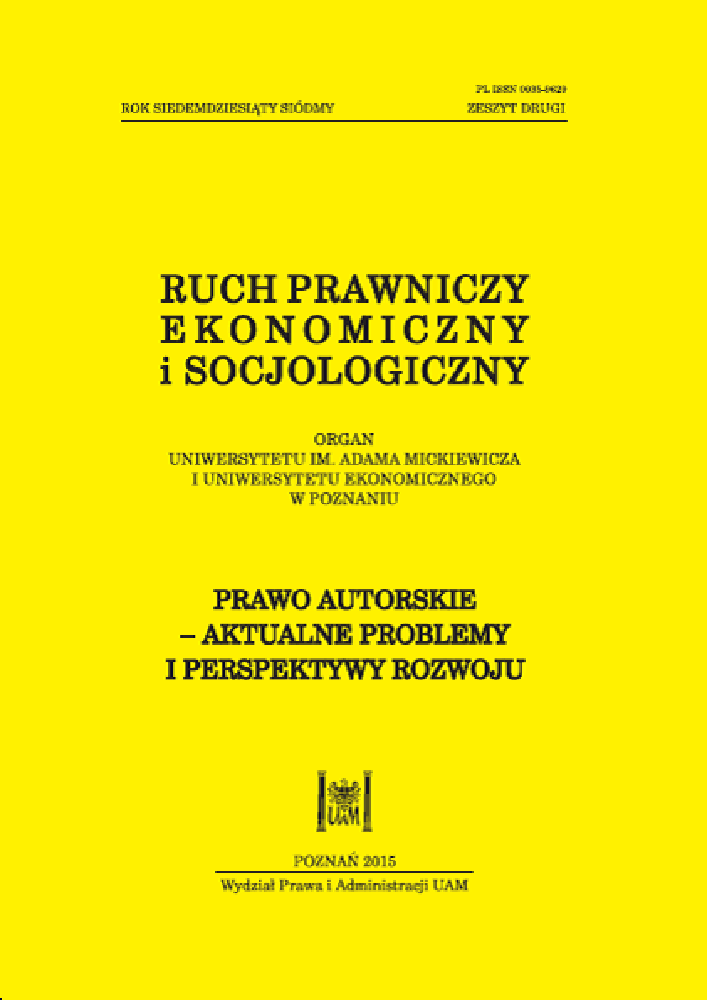Abstrakt
Od początków istnienia nowoczesnej branży odzieżowej, producenci mody byli ofiarami nieautoryzowanego kopiowania i nieuczciwej konkurencji. Jednakże wraz z powstaniem segmentu szybkiej mody, rozwojem technologii cyfrowych, Internetu i mediów społecznościowych proces ten się nasilił, a piractwo modowe stanowi obecnie zorganizowany przemysł wart miliardy dolarów. Złożoność problemu, specyfika branży odzieżowej i ambiwalencja samych producentów mody w kwestii kopiowania powodują, że piractwo w modzie jest kwestią często dyskutowaną wśród modowych profesjonalistów, prawników, dziennikarzy i naukowców. Mimo nasilającego się trendu obejmowania prawem projektantów i wzornictwa modowego, obserwujemy również próby kwestionowania zasadności wprowadzania prawa autorskiego do mody i wskazywania pozytywnych skutków piractwa w specyficznej branży odzieżowej. Celem niniejszego artykułu jest ukazanie historycznego procesu budowania złożonych relacji między modą i prawem w społeczeństwach nowoczesnych oraz omówienie różnych sposób postrzegania kwestii prawa własności intelektualnej w tej branży.
Bibliografia
Barnett, J.M. (2005), Shopping for Gucci on Canal Street: Reflections on Status Consumption, Intellectual Property, and The Incentive Thesis, Virginia Law Review 91(6): s. 1381-1423.
Berry, C. (1994), The Idea of Luxury. A Conceptual and Historical Investigation, Cambridge University Press, Cambridge.
Bollier, D., Racine, L. (2005), Ready to Share: Creativity in Fashion & Design Culture, tinyurl.com/2uedyoe [dostęp 15.12.2014].
Busch, O. von (2008), Fashion-able. Hacktivism and Engaged Fashion Design, University of Gothenburg, Göteborg.
Cox, Ch., Jenkins, J. (2005), Between the Seams, A Fertile Commons: An Overview of the Relationship Between Fashion and Intellectual Property, tinyurl.com/p8zpduv [dostęp 15.01.2015]
Dior, Ch. (1957), Christian Dior and I, E.P. Dutton & Company, New York.
Evans, C. (2013), The Mechanical Smile. Modernism and the First Fashion Shows in France and America, 1900-1929, Yale Univ. Press, New Heaven-London.
Le Fèvre, G. (1929), Au secours de la couture (industrie française), Paris.
Foucault, M. (1984), What Is an Author?, w: Rabinow, P. (ed.), The Foucault Reader, Penguin, London: 101-120.
Garnier, G. (1987) Paris-Couture-Annés trente, Musée de la Mode & du Costume, Paris.
Gliściński, K., Narodziny Autora, tinyurl.com/mporuqs [dostęp 17.03.2015]
Global Fashion Industry Statistics: Global Apparel Market, tinyurl.com/ld25lqe [dostęp 30.12.2014].
Green, N.L. (1994) Art and Industry: Language of Modernization in the Production of Fashion, French Historical Studies 18(3): 722-748.
Green, N.L. (1997), Ready-to-Wear and Ready-to-Work: A Century of Industry and Immigrants in Paris and New York, New York-Durham.
Hawes, E. (1938), Fashion is Spinach, Random House, New York.
Hemphil, S.C., Suk, J. (2009), The Law, Culture, And Economics Of Fashion, Stanford Law Review 61(5): 1147-1199.
Jaszi, P., Woodmansee, M. (1996), Ethical Reaches of Authorship, The South Atlantic Quarterly 95(4): 947-977.
Kępiński, J. (2010), Wzór przemysłowy i jego ochrona w prawie polskim i wspólnotowym, Wolters Kluwer, Warszawa.
Kirke, B. (1998), Madeleine Vionnet, Chronical Books, San Francisco.
Lipovetsky, G. (1994), The Empire of Fashion: Dressing Modern Democracy, Princeton University Press, Princeton.
Marcketti, S.B., Parsons, J.L. (2006), Design Piracy and Self-Regulation: The Fashion Originators' Guild of America, 1932-1941, Clothing and Textiles Research Journal 24(3): 214-228.
Marshall, L. (2001), Losing One’s Mind: Bootlegging and the Sociology of Copyright, (Ph.D. dissertation), University of Warwick, Coventry.
Nowak-Gruca, A. (2013), Cywilnoprawna ochrona praw majątkowych w świetle ekonomicznej analizy prawa, Wolters Kluwer, Warszawa.
Pfister, L. (2010), Author and Work in the French Print Privileges System: Some Milestones, w: Deazley, R., Kretschmer, M., Bently, L. (eds.) Privilege and Property. Essays on the History of Copyright, Open Book Publishers, Cambridge: 115-136.
Pouillard, V. (2008), In the Shadow of Paris? French Haute Couture and Belgian Fashion Between the Wars, w: Blaszczyk, R.L. (ed.), Producing Fashion Commerce, Culture, and Consumers, University of Pennsylvania Press, Philadelphia: 62-81.
Poźniak-Niedzielska, M. (2007), Ochrona wzorów przemysłowych w prawie europejskim, Europejski Przegląd Sądowy 1: 4-11.
Promińska, U. (2004), Prawo własności przemysłowej, Warszawa.
Raciniewska, A. (2013), Luksus w czasie kryzysu, Kultura Współczesna 4(79): 29-41.
Raustiala, K., Sprigman, Ch. (2006), The Piracy Paradox: Innovation and Intellectual Property in Fashion Design, Virginia Annual Law Review 92(8), s. 1687-1777.
Rose, M. (1994), Authors and Owners. The Invention of Copyright, Harvard University Press, London.
Scafidi, S. (2006), A Bill to Provide Protection for Fashion Design. Hearing on H.R. 5055 before the Subcommittee on Courts, the Internet, and Intellectual Property of The Committee on the Judiciary House of Representatives, 109th Congress, 2006, s. 77- 84, tinyurl.com/pcj4fzp [dostęp 12.12.2014.]
Scafidi, S. (2006), Intellectual Property and Fashion Design, w: Yu, P.K. (ed.), Intellectual Property and Information Wealth: Issues and Practices in the Digital Age, t. 1, Praeger Publishers, Westport: 115-131.
Stewart, M.L. (2005), Copying and Copyrighting Haute Couture: Democratizing Fashion, 1900-1930s, French Historical Studies 28(1): 103-130.
Troy, N. (2002), Couture Culture: A Study in Modern Art and Fashion, The MIT Press, Cambridge.
Weikart, M.A. (1944), Design Piracy, Indiana Law Journal 19(3): 235-257.
Woodmansee, M. (1994), The Author, Art and the Market: Rereading the History of Aesthetics, Columbia University Press, New York.
Licencja
Prawa autorskie (c) 2015 WPiA UAM

Utwór dostępny jest na licencji Creative Commons Uznanie autorstwa – Użycie niekomercyjne – Bez utworów zależnych 4.0 Międzynarodowe.




